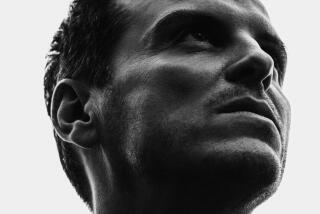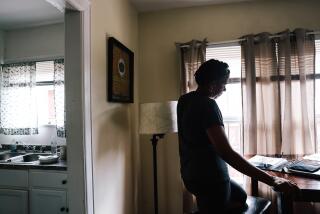Raymond Scott; Composed Quirky, Innovative Music
- Share via
Raymond Scott, the innovative composer, pianist and electronic music pioneer whose quirky works spanned the decades and musical styles from radio jazz shows to “Your Hit Parade” to Nickelodeon’s hit cartoon, “The Ren & Stimpy Show,” has died. He was 85.
Scott, who lived in Van Nuys, died of pneumonia Tuesday at a nursing home in North Hills. He had been unable to speak and was largely incapacitated by a series of strokes that began in 1987.
He began composing in the 1930s, and his works had recently enjoyed a resurgence of popularity with Columbia’s CD reissue last year of “The Music of Raymond Scott: Reckless Nights and Turkish Twilights.” The recordings are currently heard on the cult cartoon favorite “Ren & Stimpy.”
Another recent album, “The Raymond Scott Project, Volume 1: Powerhouse” has been released by Stash Records.
Several music and animation experts are attempting to preserve Scott’s musical output at the Marr Sound Archives of the University of Missouri in Kansas City. “This is irreplaceable stuff,” Mix magazine columnist David Goggin, who is involved in the archive effort, told The Times last year. “We feel that in 100 years historians will be very curious about this lone genius.”
Scott first gained fame with his six-piece “Quintet” (so-called because he preferred the sound of the word to “sextet” and didn’t count himself) in the late 1930s, playing his swing “Powerhouse” and other compositions on CBS radio and in concerts.
“Scott’s music has been called ‘instrumental literature,’ ‘program jazz’ and other things,” Times Hollywood columnist Philip K. Scheuer said in 1937. “It sounds like dissonant ragtime, the dissonances providing the modern, or arty, touch; and it’s often pretty swell.”
Scott went on to lead big bands in the 1940s, and in 1943, as music director for CBS, formed the first racially mixed radio orchestra. In 1946 he wrote the music to Bernard Hanighen’s lyrics for the Broadway musical “Lute Song” starring Mary Martin and Yul Brynner.
Although Scott did not specifically compose for cartoons, more than a dozen of his mixed jazz, pop and classical compositions were used by Warner Bros. music director Carl Stalling in the soundtracks accompanying Bugs Bunny, Daffy Duck, Elmer Fudd and Porky Pig in “Merrie Melodies” and “Looney Tunes” in the 1940s. In 1989, East Orange, N.J., radio personality Irwin Chusid became a Scott fan and worked to obtain credit and royalties for Scott for all his compositions and to develop the 1993 CD.
“His quintet was music for the 20th Century,” Chusid told The Times last year, describing how he got hooked on Scott’s music when a fan sent him a 1930s record to play on the air. “It was pop in the best sense of the word: catchy, memorable, with melodies that would just get lodged in your subconscious, and you could not get rid of them.”
From 1950 to 1957, Scott conducted the orchestra on the NBC television series “Your Hit Parade,” for which he composed the opening and closing tunes, “Be Happy” and “So Long for a While.”
“The more haunting the theme the better the recognition value,” he said in 1955 at a time when he was also composing jingles for television and radio commercials. “It also generates a feeling of interest and psychologically sets the stage for the program. A happy theme denotes a happy program.”
A serious, somewhat reclusive workaholic who admitted that he had to have people make faces at him to enable him to smile for the television camera on “Hit Parade,” Scott provided a sense of fun in his music and his descriptive titles. Trumpet spooks howl in his “New Year’s Eve in a Haunted House”; tom-toms beat menacingly through “Dinner Music for a Pack of Hungry Cannibals,” and a seasick saxophone dominates “Reckless Night on Board an Ocean Liner.”
Scott was also an inventor, using early synthesizers, and in his final years he composed music on a computer. One of his earliest electronic concoctions was “Karloff,” named for the horror movie actor Boris Karloff, which imitated the sounds of kitchen clatter, jungle drums and a steak frying. His “Clavicox” was a keyboard instrument that imitated the sound of a human voice.
His “Electronium,” an instrument panel that lit up like the cockpit of a jet and which he said could compose music by itself, captured the imagination of Berry Gordy Jr. of Motown Records. Gordy hired Scott to head Motown’s electronic music division from 1972 until Scott’s retirement in 1977, and he moved Scott from his native New York to the San Fernando Valley.
Born Harry Warnow in Brooklyn, N.Y., the composer wanted to be an engineer but was persuaded by his father, who owned a music shop, and his brother, conductor Mark Warnow, to attend the Institute of Musical Art, which became the Juilliard School. Scott studied piano and upon graduation in 1931 was hired as staff pianist with the CBS radio house band, which his brother conducted.
But he soon became bored, started composing his eccentric but lasting jazz pop tunes, and organized his quintet. He picked a new name out of the New York telephone book, choosing Raymond Scott because it “sounded nice and had good rhythm.”
Previously married to Pearl Winters and Dorothy Collins, Scott is survived by his wife of 26 years, Mitzi, four children and 10 grandchildren.
More to Read
The biggest entertainment stories
Get our big stories about Hollywood, film, television, music, arts, culture and more right in your inbox as soon as they publish.
You may occasionally receive promotional content from the Los Angeles Times.










